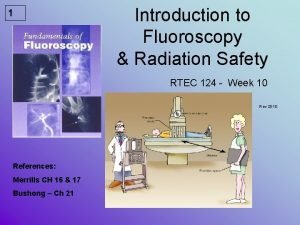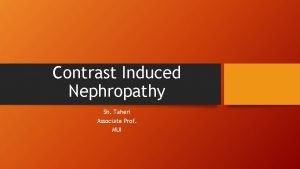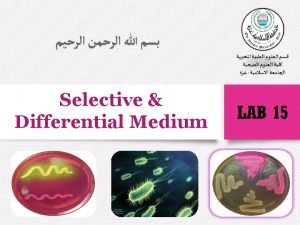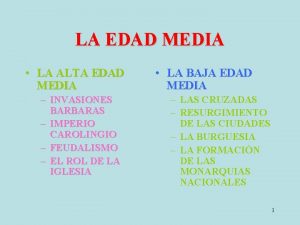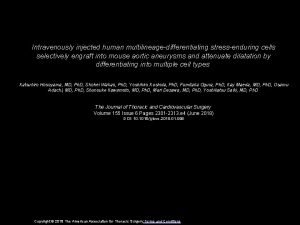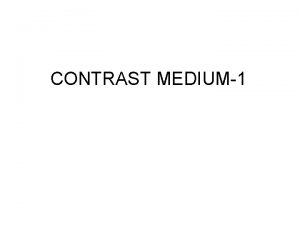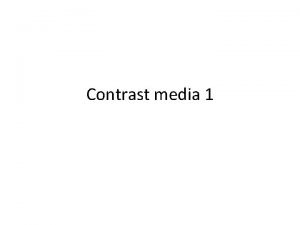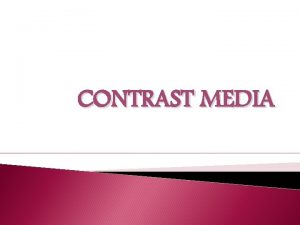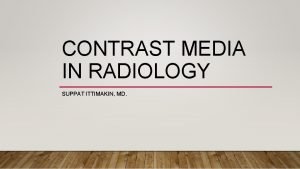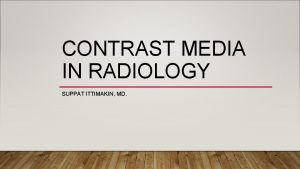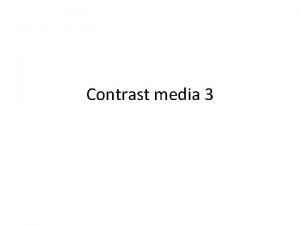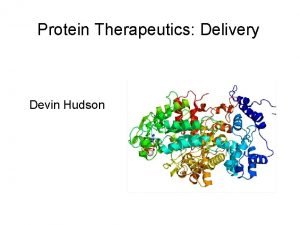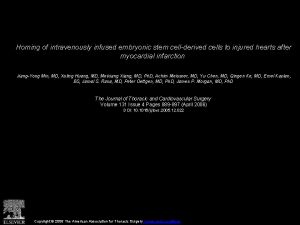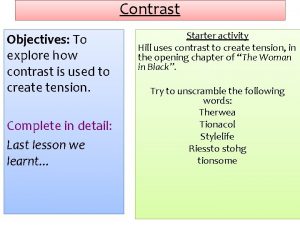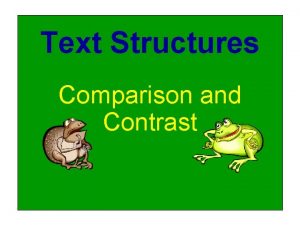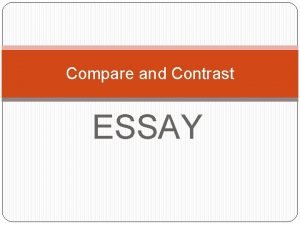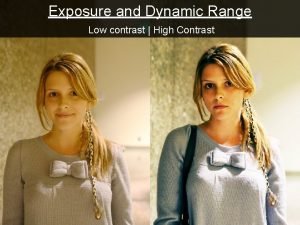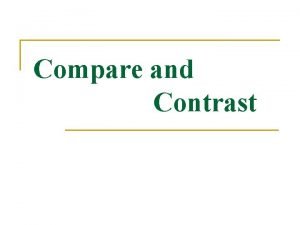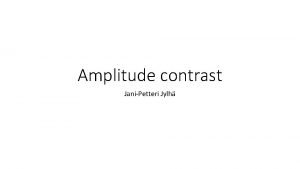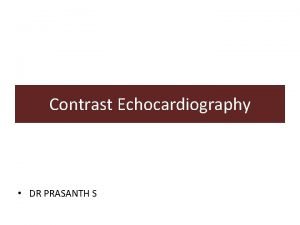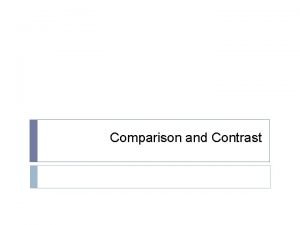The use of contrast media which injected intravenously






















































- Slides: 54












The use of contrast media which injected intravenously is important for visualization of structures within the mediastinum. Ø Ø Department protocols/radiologist preferences determine the specific type, volume and site of injection. ( Average dose 80 ml) For children 1. 5 ml per kilogram body weight.

1. To detect lesions 2. To distinguish vessels from lesions 3. To demonstrate displacement of vessels by masses 4. To demonstrate the enhancement of pathologies

切面厚度Slice thickness 切面間距Slice spacing 視野Field of view 重組函數Reconstruction algorithm 影像呈現設定Imaging display settings

Single attenuation value of voxel represents average of all attenuation of all various structures within it Thicker the slice greater the averaging called partial volume effect Partial volume effect reduced by thinner section Determined by size of structure being assessed and number of scans required to evaluate the patient

Reconstruction algorithm Lung parenchyma : high spatial algorithm High spatial algorithm reduces smoothing Better depiction of normal and abnormal parenchymal interface Mediastinum and chest wall standard soft tissue algorithm


Slice spacing Adequate assessment of patient 10 mm interval 1 to 2 mm slice with 10 mm interval allows only 10 to 20% of lung Improved spatial resolution allows better assessment of normal and abnormal findings Pulmonary metastasis requires 5 to 7 mm thick sections Trachea and central bronchi 3 to 5 mm thick sections Pulmonary parenchyma and peripheral bronchi requires 1 to 2 mm sections

Image display settings Two parameters: window width and window level Average density of each voxel : Hounsfield unit These units are arbitrary so 0 is for water, 1000 for air Range of Hounsfield in thorax is wider ranging from -850 HU for aerated lung to 700 HU for ribs Display of images determined by window level and window width



Solitary pulmonary nodule Evaluation of diffusely CXR -Cystic fibrosis, Sarcoidosis, Interstitial lung disease, Histocytosis X, ARDS

A narrow slice width is used (usually 1– 2 mm) A high spatial resolution image reconstruction algorithm is used Field of view is minimized, so as to minimize the size of each pixel Prone scanning

5 mm 1 mm same Reconstruction in High resolution algorithm same scan data

high resolution (sharp) SL 1 mm same position standard resolution (smooth)

A Scan FOV 40 cm B Target FOV 25 cm


Indications : General screening of Pathology Patient Position : Supine arms elevated above head Topogram: from chin to below liver Breathing Breath hold in inspiration ( single breath hold) Contrast I. V : 80 ml

C-: 5 mm/5 mm (Soft tissue widow ) from lung apices to liver n C+: 5 mm/5 mm(Soft tissue widow ) from chin to kidney n

Lung window 5 mm/5 mm (lung apices to below diaphragm) Cor. 5 mm/5 mm

Patient Position : Supine arms elevated above head Topogram : From lung apices to liver Breathing : Breath hold in inspiration ( single breath hold) Contrast I. V : 80 ml

C-: n Inspiration: 1 mm/5 mm (lung window ) from lung apices to diaphragm n Expiration: 1 mm/5 mm (lung window) from lung apices to diaphragm 5 mm/5 mm (soft window) From lung apices to liver

C+: 5 mm/5 mm (Soft tissue widow) from chin to kidney Cor. 5 mm/5 mm Lung window 5 mm/5 mm

Patient Position : Supine arms elevated above head Topogram : From chin to aortic bifurcation Breathing : Breath hold in inspiration ( single breath hold) Contrast I. V : 80 ml (2. 5 mm/s)

C-: 5 mm/5 mm (Soft tissue widow ) from lung apices to IC Bolus tracking ROI setting at aortic arch C+: 5 mm/5 mm(Soft tissue widow ) from chin to IC

Lung window 5 mm/5 mm Sag. 3 mm/3 mm Cor. . 3 mm/3 mm

CTA-VRT

















 Trenton corrosion protection
Trenton corrosion protection People media examples
People media examples Double contrast vs single contrast
Double contrast vs single contrast Classification of contrast media
Classification of contrast media Hình ảnh bộ gõ cơ thể búng tay
Hình ảnh bộ gõ cơ thể búng tay Lp html
Lp html Bổ thể
Bổ thể Tỉ lệ cơ thể trẻ em
Tỉ lệ cơ thể trẻ em Chó sói
Chó sói Tư thế worm breton
Tư thế worm breton Hát lên người ơi
Hát lên người ơi Các môn thể thao bắt đầu bằng từ đua
Các môn thể thao bắt đầu bằng từ đua Thế nào là hệ số cao nhất
Thế nào là hệ số cao nhất Các châu lục và đại dương trên thế giới
Các châu lục và đại dương trên thế giới Công thức tính độ biến thiên đông lượng
Công thức tính độ biến thiên đông lượng Trời xanh đây là của chúng ta thể thơ
Trời xanh đây là của chúng ta thể thơ Mật thư tọa độ 5x5
Mật thư tọa độ 5x5 Làm thế nào để 102-1=99
Làm thế nào để 102-1=99 độ dài liên kết
độ dài liên kết Các châu lục và đại dương trên thế giới
Các châu lục và đại dương trên thế giới Thể thơ truyền thống
Thể thơ truyền thống Quá trình desamine hóa có thể tạo ra
Quá trình desamine hóa có thể tạo ra Một số thể thơ truyền thống
Một số thể thơ truyền thống Cái miệng nó xinh thế chỉ nói điều hay thôi
Cái miệng nó xinh thế chỉ nói điều hay thôi Vẽ hình chiếu vuông góc của vật thể sau
Vẽ hình chiếu vuông góc của vật thể sau Thế nào là sự mỏi cơ
Thế nào là sự mỏi cơ đặc điểm cơ thể của người tối cổ
đặc điểm cơ thể của người tối cổ V cc
V cc Vẽ hình chiếu đứng bằng cạnh của vật thể
Vẽ hình chiếu đứng bằng cạnh của vật thể Phối cảnh
Phối cảnh Thẻ vin
Thẻ vin đại từ thay thế
đại từ thay thế điện thế nghỉ
điện thế nghỉ Tư thế ngồi viết
Tư thế ngồi viết Diễn thế sinh thái là
Diễn thế sinh thái là Dạng đột biến một nhiễm là
Dạng đột biến một nhiễm là Số nguyên tố là gì
Số nguyên tố là gì Tư thế ngồi viết
Tư thế ngồi viết Lời thề hippocrates
Lời thề hippocrates Thiếu nhi thế giới liên hoan
Thiếu nhi thế giới liên hoan ưu thế lai là gì
ưu thế lai là gì Khi nào hổ con có thể sống độc lập
Khi nào hổ con có thể sống độc lập Sự nuôi và dạy con của hươu
Sự nuôi và dạy con của hươu Hệ hô hấp
Hệ hô hấp Từ ngữ thể hiện lòng nhân hậu
Từ ngữ thể hiện lòng nhân hậu Thế nào là mạng điện lắp đặt kiểu nổi
Thế nào là mạng điện lắp đặt kiểu nổi Yesterday
Yesterday Opportunities and challenges in media information
Opportunities and challenges in media information To target specific audiences media producers may use
To target specific audiences media producers may use Selective and differential media
Selective and differential media Media by design adalah
Media by design adalah Major advertising decisions
Major advertising decisions Alta edad media y baja edad media
Alta edad media y baja edad media Caracteristicas de la baja edad media
Caracteristicas de la baja edad media Examples of hot and cold media
Examples of hot and cold media


